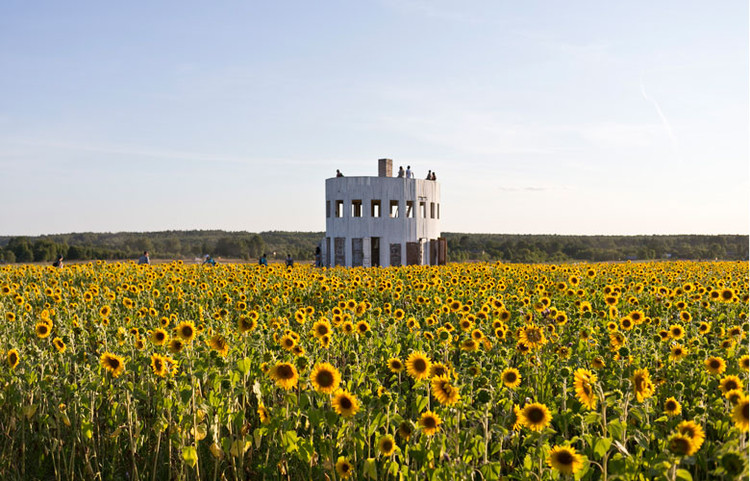
Russia is an enigmatic country known for its sublime constructivism developed during Soviet times, its greatness and enormous scale. It comes as no shocker — architects, such as Ivan Leonidov and his student Leonid Pavlov, and artists like El Lissitzky, have definitely contributed to the history and image of a strong Russian personality.
Considering the prevalent poverty in Russia, the reason for the fixation on cheap construction is rather clear. However, even local leading architects find something attractive and beautiful in the suburban barns and flimsy dwellings. Creating authentic installations in the shape of houses or changing and enhancing the experience of existing structures with materials at hand, Russian artists and architects express the country's skill of turning the ruined and inhabitable into the lively and cozy.
Villa Rotonda
Alexander Brodsky

One of the clusters for this phenomenon is Archstoyanie, an annual festival, which takes place in an art park called Nikola-Lenivets, located about 200 kilometers south-west of Moscow. Every season, a few new objects rise up here — all of them are made of natural materials, blending with each other and the surrounding fields and forests. Since 2006, Archstoyanie has collected over a hundred unique objects of contemporary architecture.
Arranged in the middle of a sunflower field, the centerpiece of the festival is the Rotonda designed by renowned architect and one of the founders of visionary architecture movement in Russia, Alexander Brodsky. Characteristic for the creator, the lower level of the oval-shaped structure's perimeter is formed by a series of old doors, each found amidst the ruins of the destroyed houses in the region. Adding colors to the Rotunda, every door is a unique reminder of the past. The carcass is made of white-painted timber planks and allows the visitors to come up to the roof overlooking the boundless Russian plains, while the heart of Rotunda is a small fireplace — a sign of a welcoming home, where everybody can get together and sit down to share the happenings of their lives.
Villa PO2
Alexander Brodsky

The recent Brodsky object, built as part of the festival this year, is Villa PO2, an installation made of concrete slabs. The name of the piece refers to PO2 fencing panels used all over Russia, reminding every local of their childhood and the multiple abandoned no-entry areas fenced by this type of concrete structures. Brodsky surrounded a copse of trees with the panels, making the plants inaccessible, and cut several windows allowing the visitors to take a peek inside and feel themselves like kids trying to break the rules.
Barn
Meganom

Another significant object at Archstoyanie is the Barn built by Meganom, an office for architecture, which, between designing a central mall in Moscow and a skyscraper in New York, squeezed in a small installation reflecting the Russian culture. The wooden pitched-roof barn is remarkable for its development — having no drawings prepared in advance. The founder of the studio Yuri Grigoryan sent a last-minute message to the builders, which explained the way they were supposed to set the piece. The result is a perforated volume lit by sunlight during the day and illuminating all around from inside during the night. One would say this example shows the lack of organization — others might note incredible confidence and ability to bend with the wind.
Thread: Uniting Wall
KOSMOS Architects

As time passes and new generations take over, the phenomenon spreads around the world and discovers new shapes. Thus, a young team from Russia called Kosmos Architects brings an authentic vibe to international workshops, like "Hello Wood" in Hungary. Thread: uniting wall, built of timber planks, is not meant to divide the society, but to unite it instead. The simple structure reminds us of childhood, too, when kids would go to the family country houses every summer and freely hang out in the suburbs, where fences would serve as nothing but garden dividers.
EMA Space
KOSMOS Architects

With time, this phenomenon not only moves to new places, but also uses new materials, carries new manifestos. The above-mentioned Kosmos showed the new possibilities of architecture and materiality with Ema, a temporary cultural cluster, which occupied an abandoned factory in central Moscow during the summer of 2016. Using silver-colored insulation foil, the architects transformed the semi-ruined brick building into a futuristic cosmic space. By hanging some lights above the silver square and setting a huge white circle – the moon – in front of it, Kosmos achieved a proper feel of flying in the night skies. Hidden somewhere in an old city quarter, Ema invited passers-by to come in and join the new experience of this reused place.
Technical aesthetics and lack of resources influence architecture and art not only in Russia but all around the world. Concrete fences and wooden barns are just a small part of what inspires creatives of different fields. Wooden architecture blooming into walls covered with insulation foil marks a starting point for a new era reflecting the development of Russian society and its possibilities.










